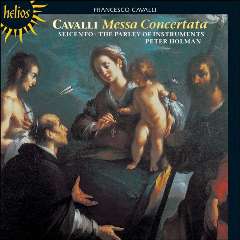Francesco Cavalli - Messa Concertata, Canzonas & Motets (1997)
Francesco Cavalli - Messa Concertata, Canzonas & Motets (1997)

Messa Concertata[38'04] 1 Kyrie[5'05] 2 Gloria[13'53] 3 Canzona a 6[4'30] 4 O quam suavis et decora[3'32] Messa Concertata[38'04] 5 Credo[12'36] 6 Canzona a 4[4'00] Messa Concertata[38'04] 7 Sanctus and Benedictus[3'08] 8 O bone Jesu, O Jesu amabilis[4'54] 9 Canzona a 3[5'10] Messa Concertata[38'04] 10 Agnus Dei[3'22] 11 Canzona a 8[3'55] Seicento The Parley of Instruments Philippa Hyde, Carys Lane - soprano Rodrigo del Pozo - tenor Timothy Roberts - organ/regal/harmonium Peter Holman - conductor
We do not know for sure when the Messa Concertata was written, but one possibility is that it was composed for the Solemn Mass that was sung in St Mark’s on 1 May 1644 to celebrate the reconciliation between the Vatican and the Duchy of Parma, who had been in dispute for the previous four years; Venice had supported Parma. Such a date certainly makes sense, for the work takes its starting point from Monteverdi’s late church music. The scoring, using two four-part vocal choirs accompanied by two violins and three trombones with continuo, is virtually the same as that of Monteverdi’s great setting of the Magnificat printed in his Selva morale of 1641. The colourful polychoral ensembles of Giovanni Gabrieli and his contemporaries, with a majority of wind instruments, have given way to more modest groups of solo voices and violins; there are no cornetts, and the trombones simply double the lower parts of the second choir. On the other hand, although most of the solos come from the first choir, there is still eight-part vocal writing with antiphonal exchanges. In the second half of the seventeenth century antiphonal writing tended to be replaced by contrasts between a solo group and a chorus.
The musical language of the Messa Concertata is also characteristic of the 1640s. Cavalli still uses Monteverdi’s methods of organizing large-scale structures, using short, contrasted sections linked like a patchwork quilt, with instrumental ritornelli punctuating the major vocal sections and articulating the structure. Cavalli, like Monteverdi, frequently uses the graceful triple-time rhythm associated with Venetian opera arias. But he does not use the aria as a structural model, as the next generation did, concerned as they were with replacing patchwork structures with fewer, larger sections organized by purely musical means. Nevertheless, Cavalli is not just a talented follower of Monteverdi. His individual voice is heard most clearly in the more reflective moments such as the striking ‘et in terra pax’ section of the Gloria, with its falling figure illustrating the word ‘terra’ (‘earth’), or the beautiful ‘Crucifixus’ section of the Credo, with its chains of gently descending dissonances. In the Agnus Dei Cavalli shows that he can write as rapt and concentrated polyphony as sixteenth-century composers such as Lassus or Palestrina.
Cavalli’s instrumental pieces (they are collectively described as ‘sonatas’ in the index of Musiche sacre but are individually labelled more precisely as ‘canzonas’) also look backwards to the sixteenth century. As we might expect, the most old-fashioned ones are those in six and eight parts. In these cases the performer is left to choose some of the instruments, the music is in a neutral contrapuntal style equally suitable for winds and strings, and the contrasts are made between high and low groups of instruments, between duple time and triple time, or between two choirs, as in Giovanni Gabrieli. The four-part canzona is an odd mixture of rather old-fashioned music scored specifically for the modern ‘string quartet’ layout. The three-part canzona is the most modern. It effectively falls into five distinct movements, has some idiomatic writing for the two violins and violoncino (a small bass violin), and ends with a soulful passage based on the four descending notes of the passacaglia, the most potent emblem of love and death in Venetian opera. The solo motets are typical of the period in their free mixture of declamation, virtuoso passage-work, and expressive triple time.
We have tried in this recording to reproduce the effect of performance under Cavalli’s direction, using a building – St Jude’s, Hampstead Garden Suburb, in London – similar in size and acoustic to St Mark’s. We have used solo voices throughout, since Italian church ensembles at the time normally sang one to a part and the Venetian concerted style was particularly focused on the interplay between soloists and instruments. The organ is a new instrument by Martin Goetze and Dominic Gwynn modelled on a type frequently used in Italian Baroque churches for continuo playing. As will be obvious to the listener, it is capable of making a much more positive and characterful contribution to the ensemble than the small chest organs with wooden pipes usually used in modern performances and recordings. ---hyperion-records.co.uk
download (mp3 @320 kbs):
yandex mediafire ulozto gett bayfiles








